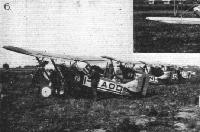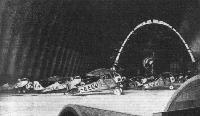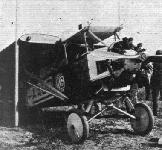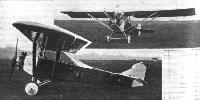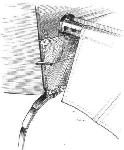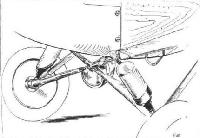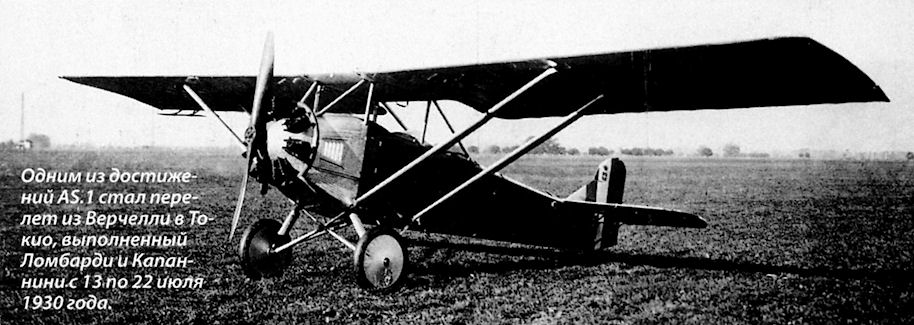
Fiat AS.1, AS.2 и TR.1
Созданный буквально за несколько недель с учетом стадии проектирования, прототип двухместного туристического самолета Fiat AS.1 поднялся в воздух летом 1928 года. Он представлял собой подкосный моноплан с крылом типа парасоль и оснащался звездообразным чешским двигателем Walter мощностью 90 л. с. (67 кВт). Внешние секции крыла могли складываться для удобства буксировки и хранения. Силовая конструкция самолета была смешанной с фанерно-полотняной обшивкой, за исключением легких металлических панелей, имевшихся непосредственно позади двигателя. На серийных AS.1 стоял двигатель Fiat A.50.
В распоряжении двух членов экипажа имелось двойное управление, сами летчики располагались по схеме тандем в открытых кабинах с небольшими ветровыми стеклами. Дополнительную защиту обеспечивало ветровое стекло, встроенное в передние стойки центроплана, что под некоторыми углами зрения создавало видимость самолета с полностью закрытой кабиной. Самолет AS.2, появившийся в 1929 году, имел усиленную конструкцию и оснащался двигателем Fiat A.50S мощностью 100 л. с. (75 кВт). Более поздние варианты обоих самолетов - AS.1 и AS.2 - уже имели полностью закрытые пилотские кабины. Еще два варианта - оснащенный двумя поплавками гидросамолет AS.1 Idro и модификация AS.1 Sci, имевшая лыжное шасси, - появились в 1930 году. Самолеты семейства AS.1 буквально не сходили с первых полос газет на протяжении 1929-1930 годов. В августе 1929 года восемь таких машин выиграли командную гонку на международных соревнованиях "Challenge Internationale de Tourisme". В январе 1930 года летчики Донати и Капаннини установили на самолете AS.1 мировые рекорды дальности и продолжительности полета в классе туристических самолетов: 2746 км и 29 часов 4 минуты соответственно. В том же месяце эти летчики установили новый мировой рекорд высоты в классе туристических самолетов - 6782 м, а в феврале Франсис Ломбардии выполнил перелет в Могадишо (Восточная Африка), преодолев за семь дней расстояние 8047 км. Но это было еще не все - 28 декабря 1932 года самолет AS.1 Idro, оснащенный двигателем CNA С7, достиг высоты 7363 м и установил мировой рекорд для туристических гидросамолетов. Два дня спустя этот же самолет, но уже с колесным шасси, поднялся на высоту 9282 м и установил мировой рекорд для туристических сухопутных самолетов. В течение 1929 года темп постройки самолетов AS.1 был ускорен, самолеты данного семейства были весьма популярны у частных владельцев, а также были приняты на вооружение ВВС Италии, где использовались в качестве связных, курьерских и учебно-тренировочных. Имеются данные, что всего было построено не менее 500 самолетов AS.1 и около 50 самолетов AS.2, а заказы итальянского Министерства обороны составили 276 самолетов AS.1 и 36 самолетов AS.2.
Варианты
TR.1: самолет имел схожую конструкцию с AS.1, но с полотняной обшивкой, ширококолейным шасси, полностью закрытой кабиной на двух членов экипажа, вписанной в задний верхний свод фюзеляжа, и силовой установкой с одним звездообразным двигателем A.50S мощностью 100 л. с. (75 кВт); первый полет состоялся в 1930 году; самолет стал победителем в ряде спортивных соревнований в 1931 году, включая командные гонки "Giro Aereo d'Italia"
ТАКТИКО-ТЕХНИЧЕСКИЕ ХАРАКТЕРИСТИКИ
Fiat AS.1
Тип: двухместный туристический и учебный самолет
Силовая установка: один звездообразный ПД Fiat А.50 мощностью 90 л. с. (67 кВт)
Летные характеристики: максимальная скорость на оптимальной высоте 158 км/ч; практический потолок 6800 м; дальность 1000 км; продолжительность полета 5 ч 30 мин
Масса: пустого 450 кг; максимальная взлетная 690 кг
Размеры: размах крыльев 10,40 м; длина 6,10 м; высота 2,53 м; площадь крыльев 17,50 м2
Описание:
- Fiat AS.1, AS.2 и TR.1
- Flight, May 1929
THE FIAT "AS.I" - Flight, June 1929
OLYMPIA AERO SHOW 1929 - Flight, April 1930
AIRCRAFT FOR THE PRIVATE OWNER
Фотографии
-
Мировая Авиация 128
Одним из достижений AS.1 стал перелет из Верчелли в Токио, выполненный Ломбарди и Капаннини с 13 по 22 июля 1930 года.
-
Flight 1930-08 / Flight
Francis Lombardi (left) and his mechanic, Capannini, and the Fiat A.S.1 monoplane (95 h.p Fiat A.50) in which they flew from Vercelli to Tokio.
-
Jane's All the World Aircraft 1980 / Encyclopedia of Aviation - Aircraft A-Z - v3
Регистрационный номер: I-AAOD [4] Fiat A.S.1 photographed during the 1929 International Tourist Challenge.
-
Flight 1929-08 / Flight
Регистрационный номер: I-AAOD [4] PETROL TEST AT THE ORLY MEETING: (6) Four Fiats A.S.I. (Fiat)
-
Flight 1929-08 / Flight
Регистрационный номер: I-AAOC, I-AAOD [4] AT ORLY: Our picture shows a scene inside the large airship hangar at Orly on the occasion of the International Light 'Plane Tour of Europe.
-
Flight 1929-08 / Flight
Регистрационный номер: I-AAOD [4] THE FOLDING TEST AT ORLY: (6) A very tight fit for the Fiat A.S.I. (Fiat engine).
-
Flight 1930-04 / Flight
On the Fiat Stand: The A.S.I is a two-seater light 'plane, which can be supplied as an "open" machine, as a coupe, and as a seaplane in both forms.
-
Air Pictorial 1958-07 / D.McKay - The FIAT Story (2)
Lombardi's Turin-Tokio A.S.1;
-
Flight 1929-05 / Flight
THE FIAT "A.S.1": Two views of the new Italian two-seater light monoplane. It is fitted with a Fiat 85 h.p A-50 air-cooled radial engine.
-
Flight 1930-04 / Flight
THE FIAT A.S.I: At Olympia the machine is shown as an open landplane. This view shows it as an open seaplane.
-
Flight 1931-02 / Flight
Регистрационный номер: I-AAVR The first A.S.2 light 'plane used by the three Italian pilots in their flight round Africa.
-
Air Pictorial 1958-07 / D.McKay - The FIAT Story (2)
Регистрационный номер: I-AAVS [2] The AS.2, a long-range cabin version of the AS.1.
-
Jane's All the World Aircraft 1980 / Encyclopedia of Aviation - Aircraft A-Z - v3
Регистрационный номер: I-AAVS [2] Fiat A.S.2.
-
Air Pictorial 1958-08 / D.McKay - The FIAT Story (3)
The TR I two-seat tourer.
-
Air-Britain Archive 1986-02
The Ethiopian Fiat AS-1 after a somewhat unconventional landing.
-
Flight 1929-07 / Flight
The tail skid on the Fiat A.S.I is a steel leaf spring.
-
Flight 1929-07 / Flight
Undercarriage and landing light on Fiat A.S.I.
- Фотографии



